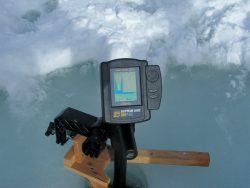ELECTRONICS
 Fish finders have come a long way. Back in the day, icemen were happy to know the depth of the water beneath their hole. We would hang a weight on a string and drop it to the bottom. The measured string would tell us the depth.
Fish finders have come a long way. Back in the day, icemen were happy to know the depth of the water beneath their hole. We would hang a weight on a string and drop it to the bottom. The measured string would tell us the depth.
New electronics share so much more information. You can now learn temperature, take video of the fish, set alarms when fish are near, and see your bait or jig in action. Some small bobber style fish finders float in the hole and send information to your Smart Phone through an app. The key to all these units is learning how to use them and experience.
Basic fish finders can cost less than $200. Units like the Fishing Buddy have an extendable shaft to reach to the bottom of deep ice. Once adjusted, you can see the fish and jig. The temperature and depth will show up as well. This information is important for a successful day on the ice.
Vexilar’s, Marcum’s, and Piranhas will also display this information. The cost of these units can exceed $1,000. The user needs to be proficient with their screens and capabilities. The circular colored screen of a Vexilar style fish finder is hard for some to interpret. The more traditional vertical screens are easier to read. These units certainly help but I have never been out fished by someone using a superior electronic fish finder. Paying attention to jigging, baits, and technique will win every time. Technology Gurus will argue this point but that justifies their costly investment. Many fishermen are looking for the edge to catch more fish. Reliance on technology can be detrimental to catching fish if you do not also pay attention to other important fishing skills.
Tuning your settings is important. One day I was filling the ice with perch while the guy next to me was moving because his electronics showed no fish in the area. He moved several times and when he turned off his unit and fished next to me, he caught his limit. Portable fish finders may also require a heater or insulation to keep them warm. Without this help, false readings can show up.
Keep the unit near the holes you are fishing. In this way you can make instant adjustments. The side scan feature of the Fishing Buddy scanner can be helpful. You can search a 360-degree area around and away from your hole. Now simply move to that location and cut another hole or adjust your depth as needed. Fish alarms will sound off when a fish is approaching. Using cleared snow, for more light, chum or scent will help to attract the fish to your area. Now check the depth and adjust to the fish. Jigging or more attention to your rig will help you see the bite.
Using GPS units will also help you remember structure or lucky spots for future trips. Even if the ice moves, your GPS will mark the exact positions you want. You can also get this data using a boat, when no ice is around. Save the data and keep for later ice use.
Electronics are helpful but not the one most important thing when ice fishing. The one thing about fishing is that there is never just one thing!
Fish for Fun!
Montana Grant
For more Montana Grant, catch him at www.montanagrantfishing.com or on Facebook.